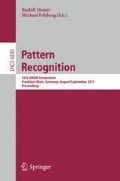Abstract
Vision-based motion perception builds primarily on the concept of optical flow. Modern optical flow approaches suffer from several shortcomings, especially in real, non-ideal scenarios such as traffic scenes. Non-constant illumination conditions in consecutive frames of the input image sequence are among these shortcomings. We propose and evaluate the application of intrinsically illumination-invariant census transforms within a dense state-of-the-art variational optical flow computation scheme. Our technique improves robustness against illumination changes, caused either by altering physical illumination or camera parameter adjustments. Since census signatures can be implemented quite efficiently, the resulting optical flow fields can be computed in real-time.
Access this chapter
Tax calculation will be finalised at checkout
Purchases are for personal use only
Preview
Unable to display preview. Download preview PDF.
References
Baker, S., Scharstein, D., Lewis, J., Roth, S., Black, M., Szeliski, R.: A database and evaluation methodology for optical flow. International Journal of Computer Vision 92(1), 1–31 (2011)
Brox, T., Bregler, C., Malik, J.: Large displacement optical flow. In: IEEE International Conference on Computer Vision and Pattern Recognition, Miami Beach, Florida, USA (2009)
Bruhn, A., Weickert, J., Schnörr, C.: Lucas/Kanade meets Horn/Schunck: Combining local and global optic flow methods. International Journal of Computer Vision 61(3), 211–231 (2005)
Chambolle, A.: An algorithm for total variation minimization and applications. Journal of Mathematical Imaging and Vision 20(1-2), 89–97 (2004)
Chambolle, A., Pock, T.: A first-order primal-dual algorithm for convex problems with applications to imaging (2010), http://hal.archives-ouvertes.fr/hal-00490826/en/
Friedrich, H., Rabe, C., Mester, R.: DAGM 2011 AVCC website (2011), http://www.dagm2011.org/adverse-vision-conditions-challenge.html
Hirschmüller, H., Gehrig, S.: Stereo matching in the presence of sub-pixel calibration errors. In: IEEE Conference on Computer Vision and Pattern Recognition (2009)
Horn, B.K.P., Schunck, B.G.: Determining optical flow. Artificial Intelligence 17, 185–203 (1981)
Mileva, Y., Bruhn, A., Weickert, J.: Illumination-robust variational optical flow with photometric invariants. In: Hamprecht, F.A., Schnörr, C., Jähne, B. (eds.) DAGM 2007. LNCS, vol. 4713, pp. 152–162. Springer, Heidelberg (2007)
Rudin, L.I., Osher, S., Fatemi, E.: Nonlinear total variation based noise removal algorithms. Physica D 60, 259–268 (1992)
Stein, F.J.: Efficient computation of optical flow using the census transform. In: Rasmussen, C.E., Bülthoff, H.H., Schölkopf, B., Giese, M.A. (eds.) DAGM 2004. LNCS, vol. 3175, pp. 79–86. Springer, Heidelberg (2004)
Steinbrücker, F., Pock, T., Cremers, D.: Advanced data terms for variational optic flow estimation. In: Vision, Modelling, and Visualization Workshop, Braunschweig, Germany (2009)
Wedel, A., Meissner, A., Rabe, C., Franke, U., Cremers, D.: Detection and segmentation of independently moving objects from dense scene flow. In: Energy Minimization Methods in Computer Vision and Pattern Recognition (2009)
Wedel, A., Pock, T., Zach, C., Bischof, H., Cremers, D.: An improved algorithm for TV-L1 optical flow. In: Cremers, D., Rosenhahn, B., Yuille, A.L., Schmidt, F.R. (eds.) Statistical and Geometrical Approaches to Visual Motion Analysis. LNCS, vol. 5604, pp. 23–45. Springer, Heidelberg (2009)
Zach, C., Pock, T., Bischof, H.: A duality based approach for realtime TV-L1 optical flow. In: Hamprecht, F.A., Schnörr, C., Jähne, B. (eds.) DAGM 2007. LNCS, vol. 4713, pp. 214–223. Springer, Heidelberg (2007)
Author information
Authors and Affiliations
Editor information
Editors and Affiliations
Rights and permissions
Copyright information
© 2011 Springer-Verlag Berlin Heidelberg
About this paper
Cite this paper
Müller, T., Rabe, C., Rannacher, J., Franke, U., Mester, R. (2011). Illumination-Robust Dense Optical Flow Using Census Signatures. In: Mester, R., Felsberg, M. (eds) Pattern Recognition. DAGM 2011. Lecture Notes in Computer Science, vol 6835. Springer, Berlin, Heidelberg. https://doi.org/10.1007/978-3-642-23123-0_24
Download citation
DOI: https://doi.org/10.1007/978-3-642-23123-0_24
Publisher Name: Springer, Berlin, Heidelberg
Print ISBN: 978-3-642-23122-3
Online ISBN: 978-3-642-23123-0
eBook Packages: Computer ScienceComputer Science (R0)

